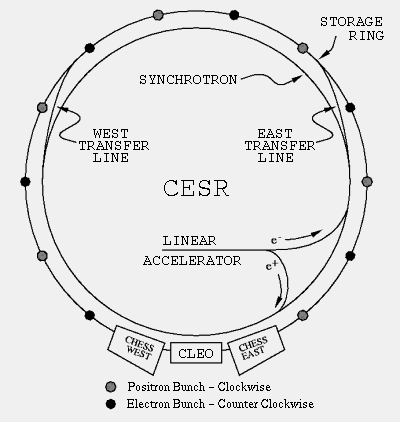
The Cornell Electron-positron Storage Ring (CESR) is an electron-positron collider with a circumference of 768 meters, located 12 meters below a parking lot and an athletic field on the scenic Cornell University campus. It is capable of producing collisions between electrons and their anti-particles, positrons, with center-of-mass energies between 9 and 12 GeV. When an electron and positron collide and annihilate, the flash of energy results in the creation of of new matter, sometimes exotic and unfamiliar. The products of these collisions are studied with a large and complex detection apparatus, called the CLEO detector.
To create these collisions, electrons and positrons are accelerated in a linear accelerator (LINAC) to an energy of about 150 MeV. They are injected into the synchrotron and accelerated to 5 GeV before being transferred to the storage ring. Identify the parts of CESR in this MPEG clip (2300 kbyte).
Electrons and positrons travel around the storage ring in bunches at 390 thousand revolutions per second (kHz), with 9 approximately evenly spaced bunch trains of two bunches of electrons each colliding with 18 similarly spaced bunches of positrons traveling in the opposite direction. Electrostatic separators are used to prevent the beams from colliding at the beam intersection points other than the South experiment area. Fly around the parts of CESR and into the beam line in this MPEG clip (1250 kbyte).
The circulating electron and positron beams emit synchrotron radiation in the form of X-rays tangential to the beam orbit. This byproduct radiation is valuable as a research tool in its own right. The beams are many thousands of times brighter and better collimated than those available from normal laboratory X-ray sources. At the time CESR was built, a separate laboratory organization was set up to exploit the research possibilities: the Cornell High Energy Synchrotron Source CHESS.
To carry out the various operations in the acceleration sequence, transferring the particles beams from one unit to another, many components must be operated at precise levels and changed in a carefully controlled sequence. In the storage ring alone more than 400 separate magnets must have their excitation currents set and monitored, often to an accuracy of 0.01%. Since separate manual controls would not be practical, the accelerator operator relies on a system of linked computers following programs that provide the instructions to each of the hundreds of components. Other programs display graphs or tables to keep the operator informed of the status of each component, and audio signals are used whenever some malfunction is detected.
The CESR scoreboard and status page summarize the machine status and performance over the last 24 hours.